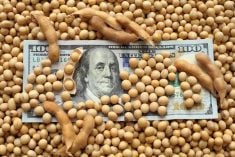Chicago | Reuters — Chicago Mercantile Exchange live cattle closed higher on Wednesday, after bargain buying reversed earlier losses following China’s proposed tariff increase on U.S. beef, said traders.
China listed beef and other U.S. goods that may incur a 25 per cent duty by the end of May if Washington makes good on threats to raise tariffs on $50 billion in Chinese goods (all figures US$).
April live cattle closed up 1.05 cents/lb. at 113.025 cents, and June ended 2.7 cents higher at 102.325.
In June 2017, U.S. beef exports returned to China after a 13-year absence over BSE worries. U.S. beef exports to China after the market reopened in the second half of 2017 totaled 3,020 tonnes valued at $31 million, according to the U.S. Meat Export Federation (USMEF).
Read Also

India slaps 30 per cent import duty on yellow peas
India has imposed a 30 per cent duty on yellow pea imports with a bill of lading date on or after Nov. 1, 2025.
“We have more beef supplies this year than a year ago, so we’re definitely looking for ways to either export that or consume it,” said Midwest Market Solutions analyst Brian Hoops.
China is viewed as an opportunity for growth in an effort to help absorb increased U.S. cattle supplies, he said.
Futures also drew initial pressure from lower prices for market-ready, or cash, cattle and tepid wholesale beef demand.
This week most cash cattle in the U.S. Plains brought $116-$118/cwt, down from mostly $120-$121 last week.
Short-covering, higher live cattle futures and lower corn prices rallied CME feeder cattle. April feeders closed 3.975 cents higher at 134.5 cents.
Hogs snap losing skid
CME hogs closed up sharply after bargain buying and short-covering snapped futures’ three-session slide in the wake of lower cash prices and China’s newly imposed tariff on U.S. pork, said traders.
On Monday the Chinese raised duties on pork and over 100 other U.S. products after the U.S. levied higher duties on Chinese steel and aluminum.
In 2017 China/Hong Kong was the second-largest volume market for U.S. pork at 495,637 tonnes, according to the USMEF.
Hog prices have fallen for nearly two weeks amid seasonally rising supplies and lacklustre wholesale pork demand, said traders and analysts.
People are banking on spring grilling, but that is not the case where parts of the country are still experiencing winter-like weather, a trader said.
April hogs closed up 1.4 cents/lb. at 53.075 cents, and May ended 1.675 cents higher at 62.875 cents.
— Reporting for Reuters by Theopolis Waters in Chicago.











